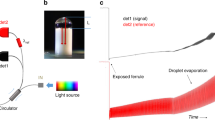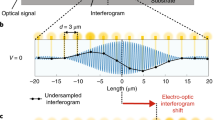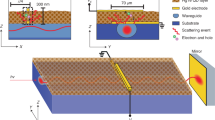Abstract
Absorption or emission spectroscopy is a powerful tool for detecting chemical compounds, diluted in fluid media: the sensitivity of this technique depends on the optical path of the source radiation, on the spectral window used for analysis and on the spectrometer performances. In this view, we designed and produced the first prototypes of an integrated scanning Fourier Transform Microinterferometer with Mach–Zehnder geometry, by using MEOS (Micro Electro Optical Systems) technologies. The microdevice, obtained by fabricating integrated optical waveguides on LiNbO3 (LN) crystals, is electrically driven, without moving parts, by exploiting the electrooptical properties of the material. The microdevice operates the Fourier Transform of the input radiation spectral distribution, which can be reconstructed starting from the output signal by means of Fast Fourier Transform (FFT) techniques. The microinterferometer weights few grams, the power consumption is of a few mW and, in principle, can operate in the LN transmittance range (0.36–4.5 μm). The microinterferometer performances were preliminary tested in the (0.4–1.7 μm) spectral window. In the Visible region (0.4–0.7 μm) this microsystem demonstrated a spectral resolution suitable for detecting the characteristic lines of the solar spectrum together with the absorption bands of common gases present in Earth’s atmosphere. In a further experiment we tested its performances for gas trace detection by using a calibrated NO2 optical gas cell, showing the possibility to reveal up to 10 ppb, when suitable optical paths are used. Finally, colorimetry tests for the titration of an organic dye (E131) in alcohol solution are presented.
Similar content being viewed by others
Avoid common mistakes on your manuscript.
Introduction
Within the process of development of size and consumption reduction of the devices, the Micro Electro Optical Systems (MEOS) can play a key role (Berger et al. 1999, ESA Report 2000): in fact, these miniaturised systems can provide a drastic reduction in dimensions without loosing rugged performances. Furthermore, they are obtained by mass production techniques, by using batch processes of planar technology, thus giving rise to cost reduction. Moreover, for all these reasons MEOS can be applied in redundancy, thus drastically reducing failure effects.
As a starting step, in the context of a Research Programme financed by ASI (The Italian Space Agency), we have designed and developed some prototypes of an integrated Mach–Zehnder Microinterferometer. The device demonstrated performances that make it suitable for gas trace sensing; furthermore, due to its reduced size, weight, power consumption, it can be envisaged as an ideal payload for space applications. To optimize the performances over a wide spectral window, three microinterferometers were integrated on a 12 cm long telescope, fabricated in carbon fibre, equipped with a spherical mirror (5 cm in diameter and 10 cm of focal length), together with the whole electronics, necessary for signal driving and collection. The small compact system can be thought as a first example of a miniaturized portable instrument suitable for open air operation.
Figure 1 reports a picture of the telescope together with the detail of a single microinterferometer.
As in any conventional interferometer, the radiation to be analysed is injected in the optical circuit and then split in two beams, each travelling through one of the two arms (Figure 2). Before the output channel the two beams are recombined and give rise to an interference pattern (interferogram), depending on the path difference produced between the two arms.
This system works as a scanning interferometer, because the output intensity is monitored as a function of the optical path variation. The resulting output interferogram \( {\text{I}}^{{{\text{tot}}}}_{{{\text{out}}}} \) (Δp), where Δp is the path difference, represents in fact the Fourier Transform of the input spectral distribution as it can be deduced by the following relationship (Driscoll et al. 1978):
where \(\kappa = 1 \mathord{\left/ {\vphantom {1 \lambda }} \right. \kern-\nulldelimiterspace} \lambda \) is the wavenumber of the incident radiation, and the integration range is extended to infinity.
In our case every moving part is avoided by exploiting the linear electrooptical effect of LN. A voltage ramp is applied to one or both arms of the interferometer, so that to produce a proportional linear variation of the optical refractive index, and a consequent optical path difference between the light beams travelling along different arms. In a balanced Mach–Zehnder configuration (same arm length) one can write:
where L is the arm length and Δn is given by:
where r33 is the linear electro-optic coefficient along the optical c-axis, ne is the LN extraordinary refractive index, and E is the electric field applied to the driving electrodes.
A sensor is synchronised with the applied voltage ramp and collects, at each voltage step, the corresponding modulated output intensity (interferogram).
The instrument resolution can be expressed by (Manzardo 2002):
and is dependent on the analysed spectral windows.
Experimental
Optically polished LN wafers, X-cut oriented, were implanted with Carbon at 3.9 MeV, and Oxygen at 5.0 MeV respectively, with implantation fluences laying in the range \({{1 \div 6 \times 10^{{18}} \,{\rm{ions}}} \mathord{\left/ {\vphantom {{1 \div 6 \times 10^{{18}} \,{\rm{ions}}} {{\rm{m}}^{{\rm{2}}} }}} \right. \kern-\nulldelimiterspace} {{\rm{m}}^{{\rm{2}}} }}\) (Bentini et al. 2002, 2004).
After the implantation process a further annealing procedure was applied in order both to recover the colour centres produced during implantation and to stabilise the damage profile. Structural and optical characterisations were performed in order to check the process results. The devices were then diced, front-end optically polished, fibre pig-tailed and finally tested in the visible/near infrared spectral region.
A 1 Hz voltage ramp with a maximum peak to peak amplitude of 80 V was applied through the electrodes: the output interferogram was then collected by a silicon photo-diode and monitored by a standard oscilloscope.
The first tests were performed by coupling a He–Ne radiation source (λ = 632.8 nm) as input signal.
With a voltage ramp varying from −40 to 40 V, the maximum refractive index variation Δn induced was close to 4 × 10−3 corresponding to an optical path difference close to 0.15 mm, as predicted by (2). Figure 3a and b report the sampled interferogram and the corresponding FFT, respectively.
The interferogram of Figure 3a presents a sinusoidal trend with a superimposed low period modulation. This effect is due to different factors. Firstly the laser line is not an ideal delta function, but has a finite width. Moreover there is the influence of the linear polarisation of the He–Ne laser incident light, in fact by applying an electric field to the arms, a rotation of the polarisation axis is produced.
This gives rise to a periodic variation of the fringe contrast. These effects can be corrected by using suitable software de-convolution procedures and are negligible in the case of broad band radiation sources. In fact, radiation sources with low coherence length were experienced, by using both common Halogen Lamps and direct Solar Radiation. The whole wavelength range of analysis is limited at higher frequencies by the photo-diode sensitivity response (400–1,100 nm in the case of a Silicon Diode, 800–1,700 nm for an InGaAs photo-detector).
It is important to underline that the Mach–Zehnder interferometer has a working spectral window that is given in principle by LN transmittance, (0.36–4.5 μm). Thus, by adjusting the geometrical characteristics of the integrated optical circuits, it is possible to obtain prototypes suitable for analyses in different regions of the specified window.
As a first test sample we directly collected, through the little telescope, the solar radiation. The results we obtained are exposed in Figure 4. Figure 4a presents the interferogram and Figure 4b, instead, reports its FFT (solid line) after the normalisation to the photo-detector responsivity function. A reference spectra is reported too (dotted line).
The spectrum we observed by pointing the sun directly in a July afternoon, shows very clearly the Fraunhofer lines.
It was also possible to observe absorption lines due to O3 near λ = 500 nm. The possibility to observe the Fraunhofer lines, suggests that that the spectral resolution is better than 1 nm. In particular, the analysis of the spectrum reveals that peaks with Half Width at Half Maximum, (HWHM), narrower than 1 nm are recorded.
In a further experiment we tested the performance of the microinterferometer for gas trace detection. A calibrated 2 cm long fused silica cell was filled with NO2 and inserted between the radiation source and the front optics of the interferometer.
The absorption spectrum of NO2 was obtained by comparing the spectrum of the light source before and after the insertion of the calibrated cell, thus performing a differential optical absorption spectroscopy (DOAS). Figure 5a reports the interferogram when the cell is inserted, whereas Figure 5b reports the spectra of the light source with and without the NO2 absorption cell.
It must be pointed out that the insertion of the gas cell produced a reduction of 30 dB in correspondence of the absorption bands of NO2.
This figure allows to evaluate a sensitivity of about 10 ppb for NO2 detection, if an optical path of about 200 m is used, (e.g., by means of a multipass White cell).
Finally we performed absorption tests (Figure 6) by introducing between the radiation source (250 W Halogen lamp) and the light injection system an optically prepared cell for chromatography, containing an organic solvent (isopropyl alcohol). Little amounts of a common organic dye (Patent Blue E131) were successively added to the cell, in order to observe the absorption phenomena induced in the collected spectra.
Figure 6 shows the experimental spectra collected by two microinterferometrs (channels), fitted on the telescope, allowing the analysis over a spectral window ranging from the Visible, (λ = 400 nm), to the near IR region, (λ = 1.7 μm). The spectrum in the visible channel was obtained by using a p-i-n Si based detector fitted on a Mach–Zehnder interferometer, whereas the spectrum obtained in the near IR channel was collected by using a p-i-n InGaAs photo-diode.
The third spectral channel, dedicated to Near-Middle IR measurements, was not operated because the detector suitable for the spectral range λ = 1.2–2.6 μm was not available at that moment.
Conclusions
The application of MEOS technologies allowed the realisation of an integrated scanning Mach–Zehnder microinterferometer on LiNbO3. The performances of the microinterferometer were preliminary tested within the VIS/NIR region (0.4–1.7 μm). The results of such tests are reported. By using the integrated microinterferometer as core device, it was possible to fabricate a very compact spectrometer. The whole instrument is composed of three microinterferometers (each one dedicated to a different spectral window), a small telescope for radiation collection and is equipped with the full miniaturised electronics, for signal driving and detection. Its weight is less than 500 g, its power consumption is lower than 3 W and can perform spectral analyses in principle on the whole transmittance region of LN (0.36–4.5 μm).
References
Bentini GG et al (2002) J Appl Phys 92(11):6447–6452
Bentini GG et al (2004) J Appl Phys 96(1):242–247
Berger JP et al (1999) Astron Astrophys Suppl Ser 139:173–177
Driscoll WG et al (1978) In: Driscoll WG, Vaughan W (eds) Handbook of optics. Optical Society of America, McGrawHill, New York
ESA Report (2000) Preparing for the future, vol. 10, no. 2, August
Manzardo O (2002) Micro-sized Fourier spectrometers. Ph.D. Thesis, University of Neuchâtel
Acknowledgment
This work has been supported by ASI-CNR contract N° I/R212/02.
Author information
Authors and Affiliations
Corresponding author
Rights and permissions
About this article
Cite this article
Bentini, G.G., Bianconi, M., Cerutti, A. et al. A New Miniaturised Optical System for Chemical Species Spectroscopic Detection Based on a Scanning Integrated Mach–Zehnder Microinterferometer on LiNbO3 . Orig Life Evol Biosph 36, 597–603 (2006). https://doi.org/10.1007/s11084-006-9052-3
Published:
Issue Date:
DOI: https://doi.org/10.1007/s11084-006-9052-3










